Yes, we have truly, honest to goodness, left St. Martin! I was beginning to think of it as home… saying hello to all the marina staff, being recognized in the grocery store across the street, hopping on the local buses to go anywhere on the island. After so much time in one place, most of us developed an affection for St. Martin. Zachary, however, was very happy to see it become increasingly smaller behind us as we sailed away this past Tuesday (February 13th). Our second attempt at a manufactured rudder was completed over the weekend and installed on Monday. We were launched in the afternoon and were thrilled with our test-drive! It was perfect and we also have a greatly increased steering radius (an adjustment we had done while the rudder was being made). Once we cleared out of customs and immigration and grabbed a few groceries, we tossed off the dock lines and pulled away from Bobby’s Marina. Our plan was to go to St. Kitts, which would be about 60 miles. We all agreed that we didn’t want to approach a new island in the dark so we decided to anchor in the Philipsburg Harbor and leave early in the morning. This allowed us a very relaxing night on anchor with a great breeze helping to clear our memories of the three-and-a-half weeks we had spent “on the hard”.
Last Friday, when we realized we would have another weekend out of the water, Tom and I decided to tackle a big boat project. We have four good sized water tanks to hold our fresh water for drinking, cooking, showering, cleaning and doing dishes. When these are all functional, this gives us about 160 gallons of water which is very reasonable. Shortly after our initial launch last June, we noticed that one of our 40 gallon tanks had a steady leak. We drained that tank and had not used it since, but we seemed to have a reasonable supply of water. A second tank developed a slow leak over the past months, but the tank was still useable. However, if the leak became worse and the tank became unuseable we would be filling our water tanks every week or less. The two leaky tanks were under our galley floor boards, yikes! We had to take up our table and bench seat and all of our galley floor boards. The tanks were then removed and taken down onto the ground to fill and evaluate the leaks. Tom repaired the leaks, purchased new hoses, and cleaned up the tanks while I scrubbed the entire bilge, now that it was accessible. This project took up our entire Saturday and Sunday, but now we have 160 gallons of fresh water available to us! Here is a picture of us bringing one of the tanks back onto the boat.
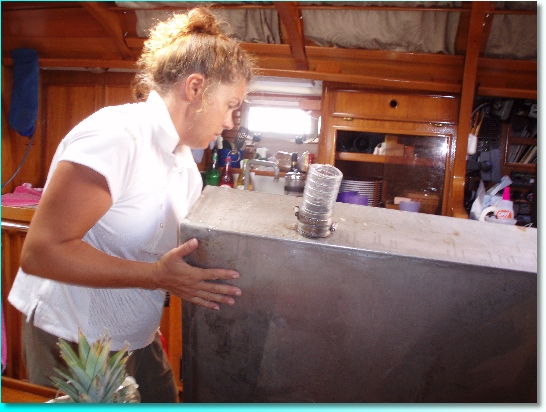
We raised anchor at 5:30 am Tuesday morning in hopes of making it to St. Kitts with some time left to go ashore and clear in through customs and immigration. What a great sail we had, and our rudder couldn’t be working better. Bobby’s Marina really went the distance to deliver a quality solution at their originally quoted price! If you are ever found to be in need of boat repairs in this area of the world, do not hesitate to use these folks.
Back to sailing … the winds were terrific and we were on one comfortable tack the whole way, averaging 7 knots boat speed. Below is a shot of St. Kitts as we were sailing along the island’s west coast. St. Kitts, as well as most of the Caribbean islands, has volcanic activity to thank for its creation. In the background are two volcanic peaks hidden in the clouds. This formation in the foreground is a structure of limestone rock which pushed its way up through the surface to create what is today called, “Brimstone Hill”.
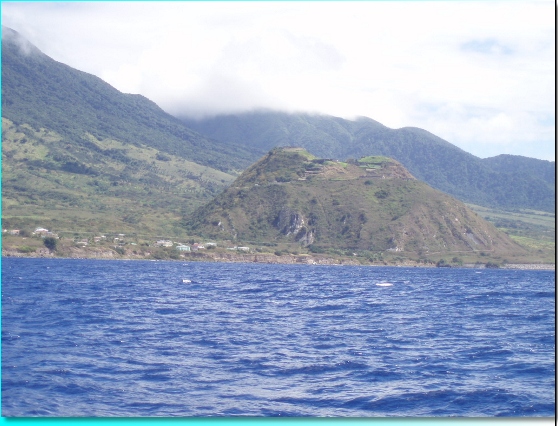
Notice the terraced areas on the top of Brimstone Hill. Over a period of 100 years, the British built a fortess here which might rival the amazing Citadel atop the hill in downtown Halifax, Nova Scotia! It is said that 1000 British troops residing in the fortress at Brimstone Hill fought off 8000 French troops for over a week. We walked from the main road — near sea level — to the top of this and were more than winded upon arrival at the top!

We took this picture from a heighth of only half-way up Brimstone Hill! The island in the distance is Statia and the shadow of an island off to the left of Statia is Saba.
The fields in the foreground of this picture show the fertile lands of St. Kitts which were used for hundreds of years to grow sugar cane. More on this topic in a bit …
Here is the first (lowest) level of the fortress; there are at least four more levels off-setting one another on the climb to the top of the hill. Each level is as fortified and protected as is seen here.
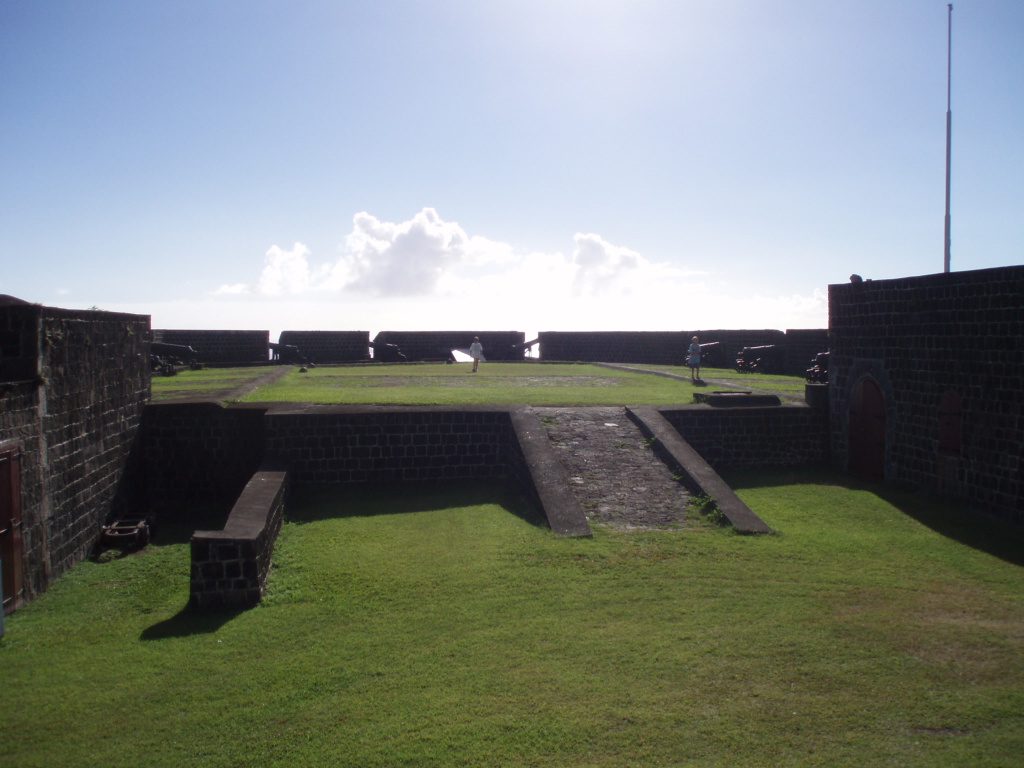
On the very top, an octogonal-shaped courtyard is sunken down into the hill and surrounded by fortified chambers, powder rooms, look-out towers and more. Here is one side of this octogonal-shaped courtyard.
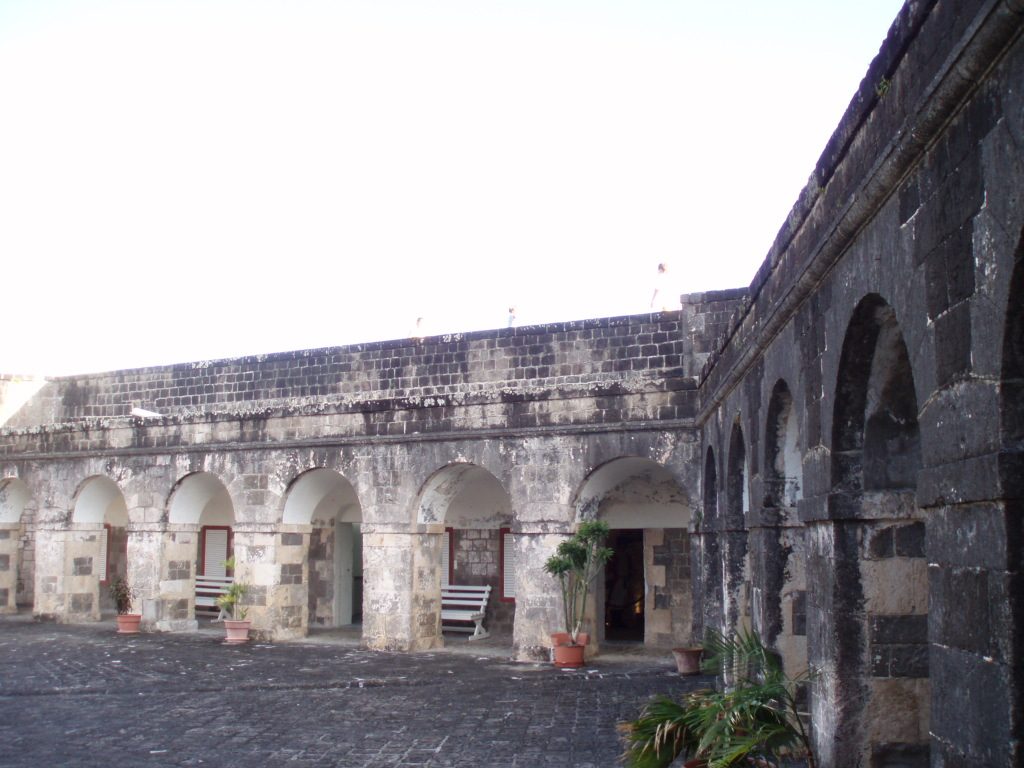
The gate as we were leaving the fortress …

As we were sailing along the coast of St. Kitts, we noticed an abundance of brick towers dotting the landscape as far as we could see. We had seen samples of these in the Virgin Islands at the ruins of sugar mill plantations. The tall, skinny brick towers are chimneys which used to be connected to boiling houses which processed the sugar cane juice by boiling down the liquid to make higher and higher concentrations of liquid sugar. The stockier towers that could be seen were likely the ruins of windmills which were used to turn rollers designed to crush the canes. As the cane is crushed, a juice is produced which passes on to the boiling house via a sluice.
Sugar production first came to St. Kitts and her sister island, Nevis, in 1648. These two islands had particularly fertile soil and were able to produce more sugar per acre of cane than surrounding sugar producing islands. Cane is a very labor intensive crop and the human resources required for managing this crop and the sugar production did not exist on the islands in the mid 1600’s. It was at this point that the British and French turned to Aftica for manual labor, beginning the slave trade here which lasted until slavery was abolished in 1834 (roughly 30 years before slavery was abolished in the United States).
By the early 1700’s, much of St. Kitts’ land was cleared and planted with cane. St. Kitts soon surpassed Nevis, Barbados and Jamaica to become the hub of British sugar trade in the West Indies. St. Kitts evantually became known throughout the region as Sugar City. St. Kitts maintained its sugar industry until July 30, 2005 when the government finally decided to exit out of sugar production after decades of declining profits.
Here is a picture of Wingfield Sugar Estate ruins …
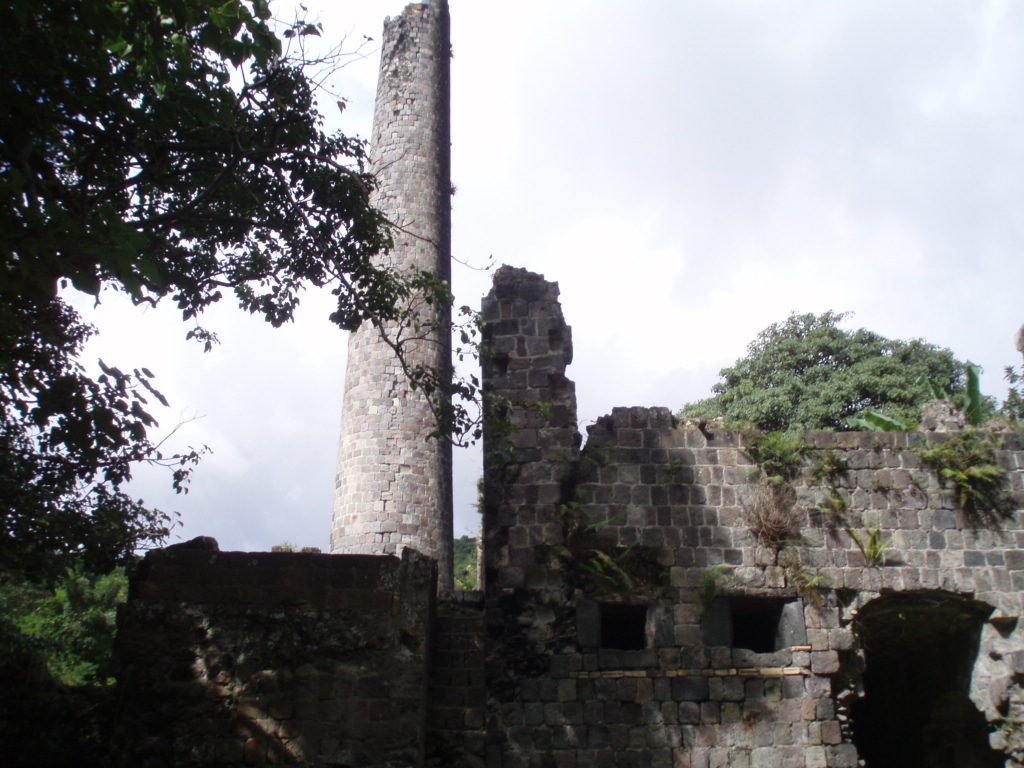
This is probably a boiling house with an attached chimney. The square openings are probably where the sluice ran into this building from where the cane was crushed to produce the juice.
We visited these ruins while hiking up to an old plantation “manor” which is now owned by a company which creates Batik fabrics. After we left the above ruins, we walked through a section of the rain forest. Here are Tom and Zachary enjoying the shade of the forest.
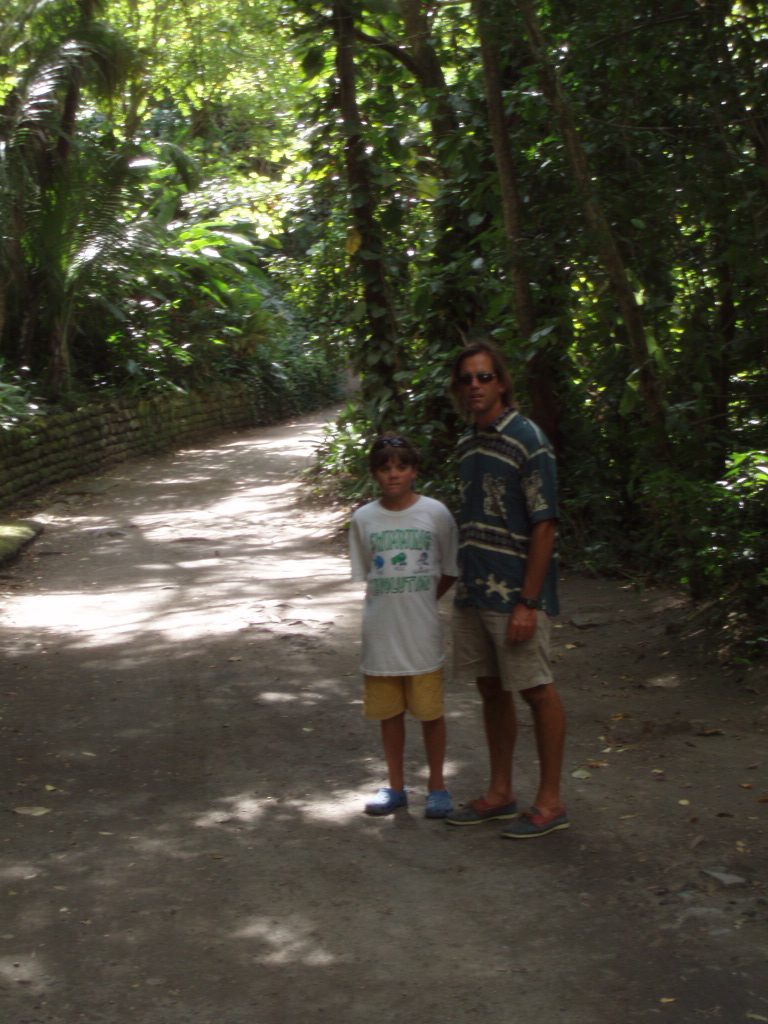
The grounds of this manor were stunning! The photo pick of this week was taken on the grounds. See our home page for that.
Here is another picture of the gardens on these grounds. Our kids are standing in front of a 350 year old Saman Tree whose branches span nearly an acre!

Finally, I will leave you with a picture of a local woman demonstrating the batik art. She is painting hot wax on to sections of this cloth before it is dyied a darker color. The areas where there is wax will not receive the color and will, therefore, remain lighter in color. When the art is complete, the article is boiled in hot water to remove all wax from the cloth. Very cool.
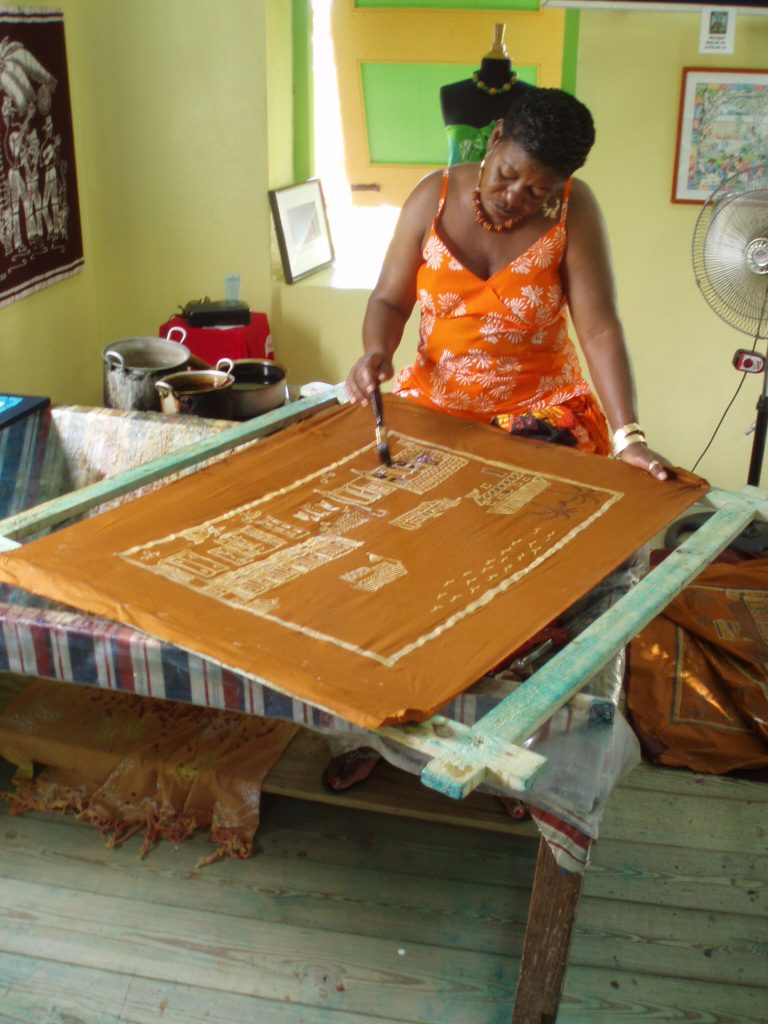
Today, we will leave our current anchorage off the island’s capital city of Basseterre for a few days of beach enjoyment at the southern end of St. Kitts. We have done our site-seeing, so it is now time to relax a bit in a quieter anchorage.
